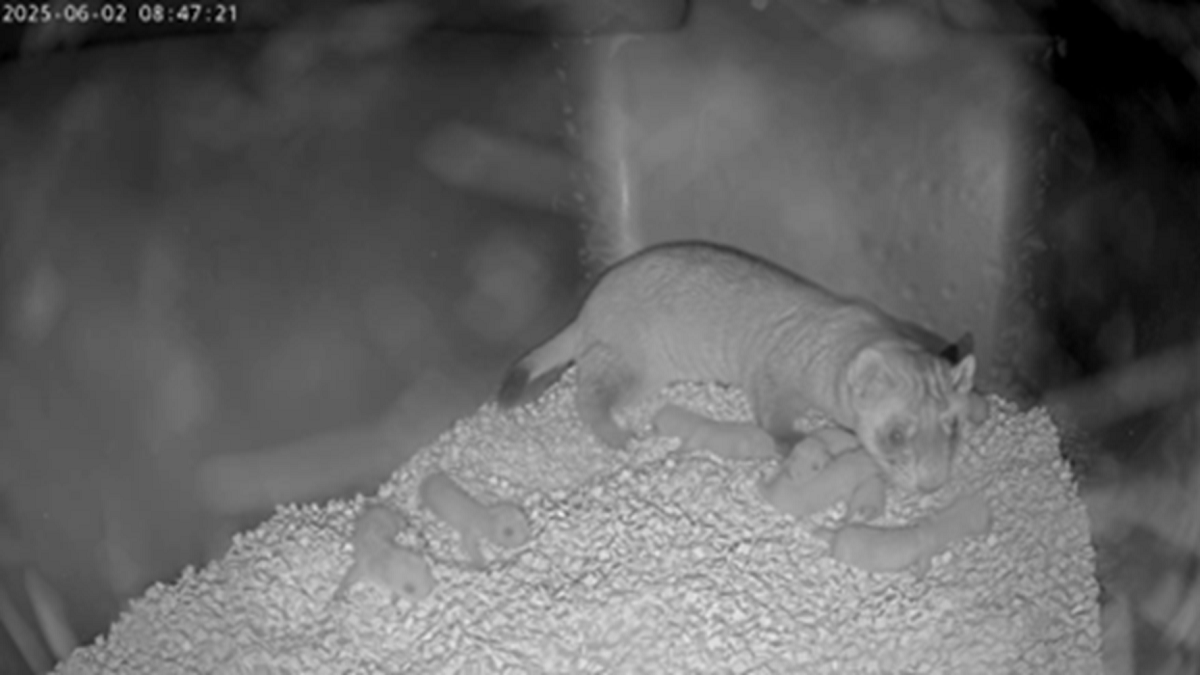
FRONT ROYAL, Va., June 2, 2025 —
Carnivore keepers at the Smithsonian’s National Zoo and Conservation Biology Institute (NZCBI) in Front Royal, Virginia, welcomed eight endangered black-footed ferret kits on May 28, born to three-year-old female Aristides. The litter, sired by two-year-old male ColeS, marks a milestone in the ongoing effort to save North America’s only native ferret species from extinction.
Animal care staff are monitoring the kits via the
Black-Footed Ferret Cam, a temporary live webcam on the NZCBI website
. Starting at four days old, the kits receive regular check-ups to ensure proper weight gain and development. A neonatal exam, scheduled when the kits reach 10 days old, will determine their sexes. The kits, born blind and weighing less than 10 grams, will develop their distinctive mask-like facial markings and dark foot markings by three weeks and open their eyes around day 37.

This is Aristides’ third litter and ColeS’ first surviving litter. Aristides, born at the Louisville Zoo, and ColeS, from the U.S. Fish and Wildlife Service (USFWS) Ferret Conservation Center in Colorado, were paired under the Association of Zoos and Aquariums’ Saving Animals From Extinction (SAFE) program. The SAFE program uses a studbook to track lineage, genetic diversity, health, and temperament, ensuring optimal breeding pairs. Aristides is one of 20 breeding female black-footed ferrets at NZCBI.
The kits will nurse for about a month before transitioning to meat. By 45 to 50 days, they will explore tunnel systems in their enclosures, designed to mimic wild prairie dog burrows. At three to four months, they will separate from Aristides. In August, the SAFE Black-Footed Ferret program will assess the genetic diversity of the captive population to decide whether the kits remain at NZCBI, move to another breeding facility, or enter the USFWS pre-conditioning program for wild release. Pre-conditioning teaches ferrets to live in burrows and hunt prey, preparing them for reintroduction.
Black-footed ferrets were thought extinct until 1981, when a colony was discovered in Meeteetse, Wyoming. The USFWS and Wyoming Game Department brought 18 ferrets into human care, launching a recovery program. Since 1989, NZCBI has contributed 1,252 kits, with over 750 reintroduced to the wild. Currently, 45 black-footed ferrets reside at NZCBI’s 3,200-acre campus, where breeding and research support conservation efforts.
The Smithsonian’s NZCBI, a leader in global species preservation, manages 250 animals across 20 species at its Virginia campus and 2,200 animals representing 400 species at its 163-acre Washington, D.C., zoo. Its work includes veterinary research, breeding programs, and training future conservationists. NZCBI collaborates with partners in 47 countries to conserve habitats and save wildlife, maintaining accreditation with the Association of Zoos and Aquariums.
The birth of these kits underscores the success of cooperative breeding programs in bolstering black-footed ferret populations. Once on the brink of extinction, the species benefits from NZCBI’s efforts to maintain genetic diversity and prepare animals for wild reintroduction. The public can follow the kits’ progress through the NZCBI’s webcam, offering a glimpse into the critical work of species conservation.







